
“Oh!” exclaimed Irene in the office when I told her I was going to Delphi, the navel of the world, the centre of the earth, the home of Pythia, the Oracle of Delphi. “You must take your shoes off and go barefoot to really feel the energy and connect with the earth.”
I am not a naturally spiritual or reverent person, and everyone tells me I have no feel for energy or auras or anything like that, so Pythia had a challenge in front of her.
Pythia was the title given to the succession of archaic priestesses who were considered to be the mouthpiece of the god Apollo – the quintessential high priestess figure, channel of earthly and feminine energy, magic and wisdom in a patriarchal society. She was the heart of Delphi from Mycenaean times until the time of the Roman Emperor Julian in the 4th century AD, when the last prophecy she made more or less notified all that the shop was under new management and she was being fired.

Delphi is the site of the Sanctuary of Apollo, situated at the exact spot where Zeus, attempting to locate the very centre of the world, launched two eagles, who, starting simultaneously from different ends of the world and flying at equal speed, crossed paths. Delphi thus became the official centre of the world. The stone which fell to earth at that spot is known as the navel of the world and is safely tucked up in the Delphi museum.
Reading more about it, Pythia may well have been largely smoke and mirrors; the chewing of bay leaves and mushrooms, chanting, trances, sitting on a tripod wreathed in smoke from holy fires, inhalation of fumes from deep cracks in the rock, from burning herbs, eternal flames, and the intoning of portentous yet vague utterances.
Prophecies such as “If you go to war, a great empire will be destroyed,” avoiding specifying which of the two warring empires would be destroyed – Greek or Persian, could rarely be proved wrong, and it struck me that deniability and in-house legal opinion was a thing even then.
However, a new year, a new me, so leaving cynicism aside and trying to channel Irene, I felt that a pilgrimage to Delphi in the cold, quiet blue of a January weekend while staying in Athens would help my search for answers and reconnect me with the Earth goddess Gaia’s power to start off the new year. A little cold to go barefoot, but anyway.
Modern Delphi, a lovely 2 and a half hour drive north-west from Athens, is a charming village enthroned in the lap of some mighty rocks and mountain tops that tower above the long and sunlit valley of the Plistos river. The view pans slowly from the hilltop village of Arachova, over the valley and across to the Gulf of Corinth, the sea glimmering below and the Peloponnese beyond. Choose a hotel on the south side of the road – the Kastalia Boutique hotel for example, and ask for a room with a view, and try the Fivos Restaurant for local wild boar braised with rosemary, cinnamon and shallots.


One way to approach the Sanctuary is to wander along part of the archaic path which connects Delphi and Kirra down on the sea. The path leaves from the village and wends its way through olive groves and tiny meadows full of wildflowers even in January, down to the sea, and is a beautiful amble through Arcadian landscape with heart-stopping views of the mountains, valley and sea all framed by waving oceans of olive trees and punctuated by occasional cypresses and shepherds sitting on rocks in the sun.






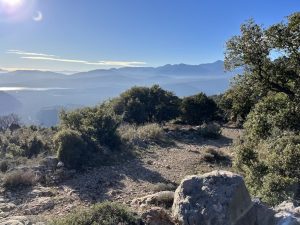
If you walk the full two hours down, you can get picked up by taxi and driven back up to Delphi. This of course is not entirely in the spirit of an ancient pilgrimage so I walked an hour down and an hour back up, (in trainers) in order to arrive at the Sanctuary in a suitably reverent and receptive frame of mind. The evening was bucolic with birdsong and as the sun sank over the western mountains, a crescent moon shone all garlanded with rosy-fingered plane contrails, the columns of the Pronea of Athena glimmered tantalisingly in the twilight – all that glory waiting for me the next morning.



Delphi is beautiful, and as the highest religious site in the ancient world, served not only as a place of worship and oracle consultation, but also provided spectacles and entertainment – athletic games and races were held at the stadium, and plays were performed at the theatre. I imagine that back in the day it was a rip-off tourist attraction with sky-high prices and as much impressive pomp as could be arranged.
In keeping with this secular aspect, the wealthier city and island states of Ancient Greece deposited their treasures and gold here for safe keeping – the richer the state, the larger and more ornate the treasury. In fact, the island of Chios, today groaning happily under the huge wealth of the vast number of shipping tonnes owned by Chiot shipping families, was even then a rich island and built the biggest of the treasuries and donated money for a vast monument to dwarf all others in return for privileged access (aka queue jumping) for its citizens wishing to consult Pythia. I mentioned this to some close Chios cousins who laughed and said that they didn’t think Chiots had changed that much over the millenia.

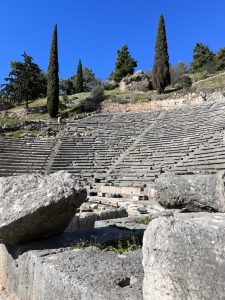






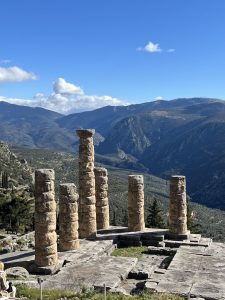
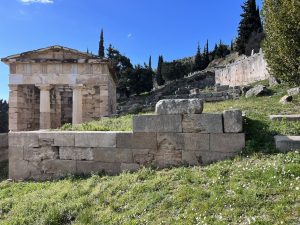

Delphi, as repository of international gold deposits, did its best to stay neutral throughout the various wars – hence the non-committal advice given to kings and leaders perhaps, though the Persians and Poseidon the earth-shaker now and then couldn’t resist sacking the place every now and then. The museum houses a unique collection of treasures, statues, friezes and monuments found by the French archaeologists who unearthed the site in the 19th century. The best known is the stupendous bronze statue of the Charioteer. Gazing into the “almond shaped eyes with the sharp transparent look,” the great modern Greek poet Seferis wrote:
“You have the impression that you are listening to a language not spoken any more…How close have we come to the soul that created this, This grace at its peak, this power, this modesty and the things that these bodies symbolize. This vital breath that makes the inanimate copper transcend the rules of logic and slip into another time, as it stands there in the cold hall of the museum.”


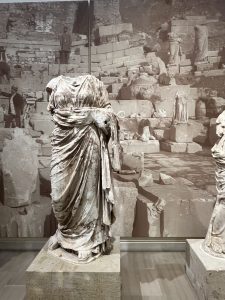


The guide books wax lyrical over the mystical energy and spirituality of the place, but even with the grandeur of the site, the miraculous landscape, the romance of sunlit ruins and eagle calls, the beautiful masterpieces, a tiny part of me was reminded of nothing so much as Switzerland – an ancient Geneva full of banks, safety deposit boxes, vaults, treasuries, art collections and grandiose headquarters of pious international committees, organisations, pretty dodgy economic and global forecasts, all bristling with public statuary and flourishing under the umbrella of neutrality.
It was the Patriarchy in full strength, and not a peep out of Mother Earth barefoot or otherwise. Poor Pythia was perhaps more of a mouthpiece of Apollo than one might have thought.
I moved on to the smaller and lower site of the Pronea of Athena. A perfect fragment of a round temple remains in the middle of heaps of fallen stones, column bases and slabs. A dog slept in front. They say that this was probably the original site of the mother goddess cult of Gaia. A cluster of wild narcissus bloomed nearby. And as the late afternoon sun slanted across the valley and tinted the marble, suddenly the glory and the energy blazed.



Did I consult the oracle? Brimming with happiness from the beauty of nature, the January sun, the light, the views, the bronze and marble, the deserted piles of sun-warmed fragments, the waving olive trees, all I could think of asking, all that I needed to know in this perfect world, was “shall I have vanilla or chocolate ice cream with my apple pie for tea?As the most famous of all Delphi’s engraved mottoes says, “Gnothi Seauton” or “Know thyself.” It is still debated whether that was practical social and military advice to know your limits and abilities, or as Plato preferred, “know your soul.” Either way, the answer was “Vanilla.”





Comments
Wonderful Ileana! After your article I too want to go, and go in winter without heat or crowds. Wasn’t the Pythia’s second most famous motto, obviously applicable to ice cream, “Nothing to excess”?
Richard Saville · February 8, 2024 · 5:17 pm ·
Quite right, and obviously not applicable to ice cream – all maxims should be taken with a pinch of salt though…
Ileana von Hirsch · February 9, 2024 · 8:35 am ·